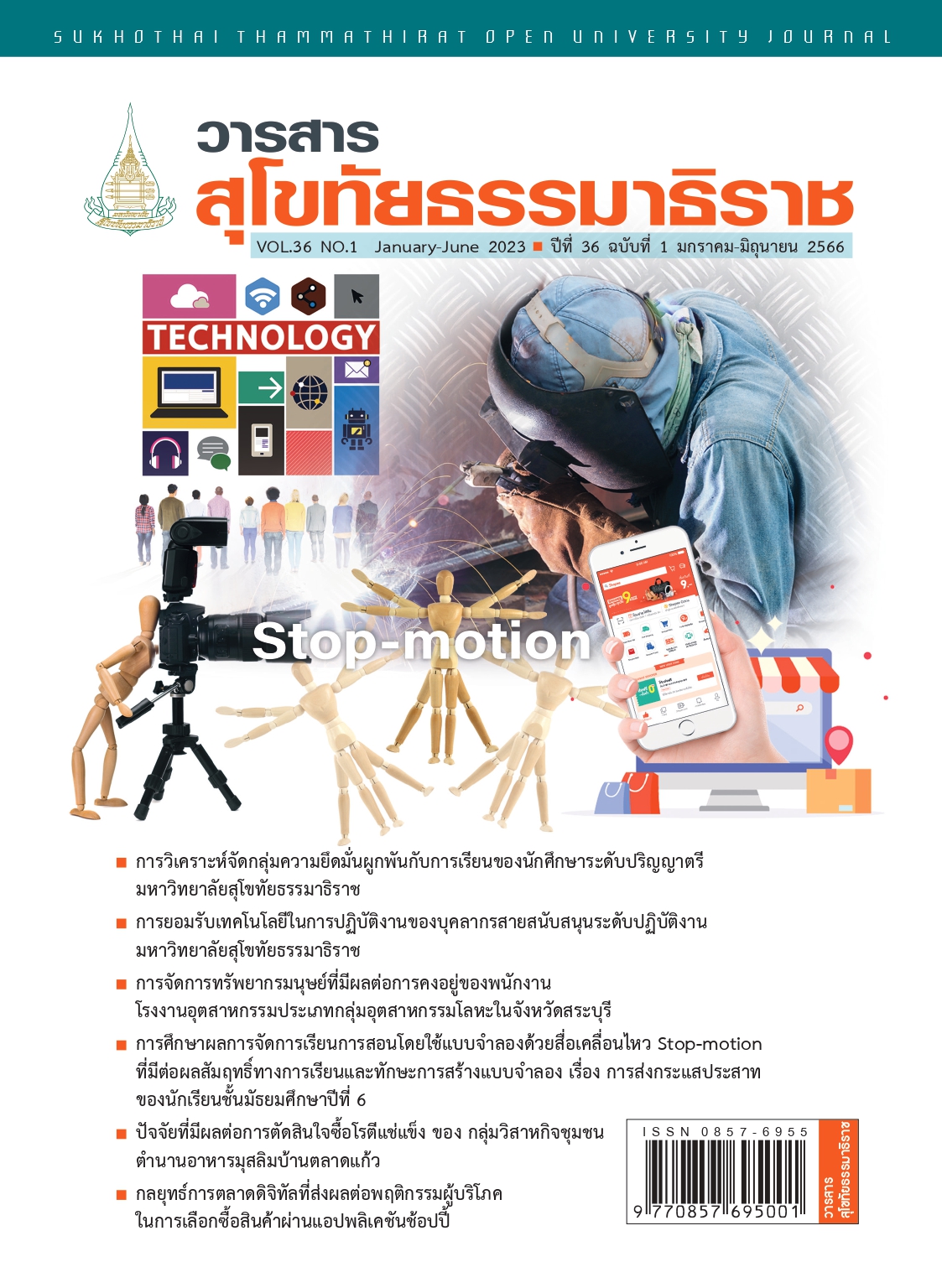A STUDY OF STOP-MOTION MODELING THAT AFFECTS ACHIEVEMENT AND MODELING SKILL OF NERVE IMPULSE FOR MATHAYOM SIXTH STUDENTS
Keywords:
Modeling learning approach, Stop-motion animation, Biology learning achievements, Modeling skillsAbstract
The objectives of this research were 1) compared biology learning of Matthayomsuksa
sixth students before and after stop-motion modeling for nerve impulses; and 2) examined the
relationship between biology learning achievement and modeling skill of Matthayomsuksa sixth
students who learned stop-motion modeling for nerve impulses. 112 samples were Matthayomsuksa
Sixth Students from three science-mathematics program classes at Phra Nakhon Si Ayutthaya
School, chosen by purposive sampling. Data was collected by pre-post biology learning
achievement test and evaluating about biology modeling skill from designed modeling skill
evaluation assignments.
Results were that biology learning achievement of Matthayomsuksa sixth students after
stop-motion modeling exceeded pretest scores at .05 level of significance. After the experiment,
the relationship between biology learning achievement and modeling skill of Matthayomsuksa sixth
students were unrelated at a statistical significance of .05.
References
Ackerman, E. (2001). Piaget’s Constructivism, Papert’s Constructionism: What’s the difference?.Retrieved from http://www.learning.media.mit.edu/content/publications/EA.Piaget%20_%20Papert.pdf
Ainsworth, S. (2006). DeFT: A conceptual framework for considering learning with multiplerepresentations. Learning and Instruction, 16(3), 183-198.
Ainsworth, S. (1999). The Functions of Multiple Representations. Computers & education, 33, 131-52.https://doi.org/10.1016/S0360-1315(99)00029-9
Anderson, L.W., Krathwohl, D. R., Airasian, P. W., Cruikshank, K. A., Mayer, R. E., Pintrich, P. R.,Raths, J.,and Wittrock, M. C. (Eds.) (2001). A Taxonomy for Learning, Teaching and Assessing: A Revision of Bloom’s Taxonomy of Educational Objectives. [Abridged Edition] New York : Longman.
Blair, J. M. (2014). Animated Autoethnographies: Stop Motion Animation as a Tool for Self-Inquiryand Personal Evaluation. Art Education, 67(2), 6-13. doi:10.1080/00043125.2014.11519259
Bryce, C. M., Baliga, V. B., De Nesnera, K. L., Fiack, D., Goetz, K., Tarjan, L. M., … Gilbert, G.S. (2016). Exploring Models in the Biology Classroom. The American Biology Teacher,78(1), 35-42. doi:10.1525/abt.2016.78.1.35
Chanatip Hotarapawanon, Sureeporn Sawangmek, and Wandee Wattanachaiyingcharoen. (2019).Developing of System Thinking for Mattayomsuksa 4 students in Nervous System and Sensory organs through Model-based Learning. Journal of Education Naresuan University, 21(2), 64-79. (in Thai)
Deaton, C. C. M., Deaton, B. E., Ivankovic, D.and Norris, F. A. (2013). Creating stop-motion videos with iPad to support students’ understandind of cell processes. Journal of Digital mLearning in Teacher Education, 30(2), 67-73. DOI: 10.1080/21532974. 2013.10784729
Ekici, E., & Fatma Ekici. (2014). Prospective Science Teachers’ Self-Assessments about the Use of Slowmation Approach in Teaching. European Journal of Social Science Education and Research, 1(1), 91-94. https://doi.org/10.26417/ejser.v1i1.p91-94.
Farrokhnia, M., Meulenbroeks, R. F. G., & van Joolingen, W. R. (2020). Student - Generated Stop-Motion Animation in Science Classes: a Systematic Literature Review. Journal of Science Education and Technology, 29(6), 797-812. doi:10.1007/s10956-020-09857-1
Fauzi, A., Rosyida, A. M., Rohma, M., and Khoiroh, D. (2021). The difficulty index of biology topicsin Indonesian Senior High School: Biology undergraduate students’ perspectives. JPBI (Jornal Pendidikan Biologi Indonesia), 7(2), 149-158. doi:https://doi.org/10.22219/jpbi.v7i2.16538
Karakoyun, F. and Yapici.İ. (2018). Use of Slowmation in Biology Teaching. International Education Studies, 11(10), 16-27. DOI: 10.5539/ies.v11n10p16
Nisit Chamnanpet, Sirinapa Kijkuakul and Maliwan Nakkuntod. (2562). Using action research to develop clay animation with model base teaching to encourage concept developing in the topic of digestive system, Journal of Education Naresuan University, 21(4), 183-197. (in Thai)
Nungruthai Kiatphimon. (2016). Effects of using Representation construction approach on modeling ability and learning achievement in biology of upper secondary school students. (Master’s Thesis). Chulalongkorn University, Faculty of Education, Program in Science Education. (in Thai)
Off ice of the Basic Education Commission. (2017). Indicators and core learning content of Department of Science (revised edition B.E. 2551) follow by Basic Education Core Curriculum B.E. 2551 (A.D. 2008). Bangkok : Agricultural cooperative printing demonstrations of Thai co., Ltd.
Piyanat Nantakarn (2008). Effect of learning by Design on biology concepts and ability in making model of upper secondary school students. (Master’s Thesis). Chulalongkorn University, Faculty of Education, Program in Science Education. (in Thai)
Schönborn, K. J., & Anderson, T. R. (2008). A Model of Factors Determining Students’ Ability to Interpret External Representations in Biochemistry. International Journal of Science Education, 31(2), 193-232. doi:10.1080/09500690701670535
Schwarz, C. V., Reiser, B. J., Davis, E. A., Kenyon, L., Achér, A., Fortus, D., Krajcik, J. (2009). Developing a learning progression for scientific modeling: Making scientific modeling accessible and meaningful for learners. Journal of Research in Science Teaching, 46(6), 632-654. doi:10.1002/tea.20311
Schweingruber, H., Keller, T., & Quinn, H. (Eds.). (2012). A Framework for K-12 Science Education: Practices, Crosscutting Concepts, and Core Ideas. National Academies Press.
Tsui, C.-Y., & Treagust, D. F. (2013). Introduction to Multiple Representations:Their Importance in Biology and Biological Education. In Multiple Representations in Biological Education (pp. 3-17). New York, NY: Springer.
Wilasinee Jansrimai, Porntip Supatchaiyawong, and Supaporn Dawan. (2020). Inquiry-based learning for develop concepts at the microscopic levels of galvanic cells through the creation of stop motion work pieces. Thaksin University Library Journal. 9(1). 58-78. (in Thai)
Wilkerson, M. H., Shareff, R., Laina, V., & Gravel, B. (2017). Epistemic gameplay and discovery in computational model-based inquiry activities. Instructional Science, 46(1), 35–60. doi:10.1007/s11251-017-9430-4.
Wipanee Chirathonphakdi. (2011). A study on biology learning achievement and analytical thinking through problem-based learning and the six thinking hats technique of matthayomsuksa 6 students. (Master’s Thesis). Srinakharinwirot University, Faculty of Sciences, Program in Science Education. (in Thai)
Xiang, L., & Passmore, C. (2014). A Framework for Model-Based Inquiry Through Agent-Based Programming. Journal of Science Education and Technology, 24(2-3), 311-329. doi:10.1007/s10956-014-9534-4
Downloads
Published
Versions
- 2024-02-01 (2)
- 2023-09-05 (1)
How to Cite
Issue
Section
License
Copyright (c) 2023 Sukhothai Thammathirat Open University

This work is licensed under a Creative Commons Attribution-NonCommercial-NoDerivatives 4.0 International License.
บทความที่ได้รับการตีพิมพ์เป็นลิขสิทธิ์ของวารสารมหาวิทยาลัยสุโขทัยธรรมาธิราช
ข้อความที่ปรากฏในบทความแต่ละเรื่องในวารสารวิชาการเล่มนี้เป็นความคิดเห็นส่วนตัวของผู้เขียนแต่ละท่านไม่เกี่ยวข้องกับมหาวิทยาลัยสุโขทัยธรรมาธิราช และคณาจารย์ท่านอื่นๆในมหาวิทยาลัยฯ แต่อย่างใด ความรับผิดชอบองค์ประกอบทั้งหมดของบทความแต่ละเรื่องเป็นของผู้เขียนแต่ละท่าน หากมีความผิดพลาดใดๆ ผู้เขียนแต่ละท่านจะรับผิดชอบบทความของตนเองแต่ผู้เดียว
ห้ามนำข้อความทั้งหมด หรือบางส่วนไปพิมพ์ซ้ำ เว้นแต่จะได้รับอนุญาตจากกองบรรณาธิการวารสาร


